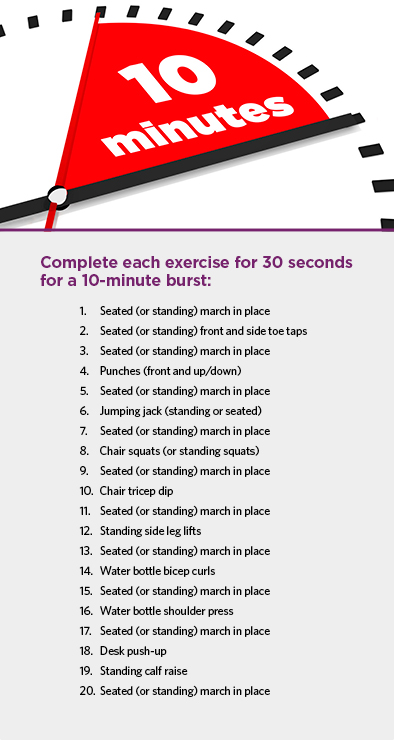Fitting physical activity into your workday
Did you know that the average American spends about eight hours and 54 minutes each day working? That’s right! About a third of our total time in a day is most likely spent sitting. Add in the average seven to eight hours per day that Americans sleep, and we have a recipe for a sedentary lifestyle and an increased risk of chronic disease.
It’s easy to understand how Americans are fitting less and less activity into their day. It can be a challenge, especially if you work in an office setting. The American College of Sports Medicine recommends at least 30 minutes of moderate activity most days of the week for good health. The bottom line: Too much sitting and not enough moving can be bad for our health. So making movement a part of our daily routine — specifically during the workday — is a great place to start! Here are a few ideas to get you started.
Get an idea of your sitting time.
Getting a baseline will help you know where to begin and let you see ways to decrease sitting time. There is a really helpful and informational tool offered by JustStand.org that can help you to calculate your sitting time and give you suggestions for reducing it. It also calculates your health risk based on your sitting time and can calculate calorie burn, too.
Brainstorm and start small.
Making this kind of change can be challenging, and it’s best to tackle in small chunks. The easiest way to get started is to brainstorm small ways to add additional steps into the workday and start trying them. Get started today with the tips below.
Commute to work:
- Get off the bus a few stops earlier.
- Park farther away from your workplace and walk.
- Stand on the bus or trolley instead of sitting.
During work:
- Have walking meetings.
- Stand during meetings or while you are on the phone.
- Move your trash bin away from your desk so you have walk to it each time.
- Print to a printer on the other side of the floor.
- Take the stairs up and down to meetings.
- Get your coffee or use the restroom on another floor.
Lunch breaks:
- Eat lunch away from your desk.
- Use half of your lunch time to walk with a friend.
- Walk to the company cafeteria rather than eating at your desk.
Break up sitting time.
Break up your sitting time by adding a calendar reminder to get up and walk once every 30 minutes. This can be as simple as taking a loop around your floor or down the hall, but those steps will start to add up before you know it. A little progress can help to motivate and prepare you for the next step.
Ten at a time.
Once you have started moving more, it’s time to step up your routine and try to get in 10 minutes at a time. This will have the greatest impact on your health and can count towards the recommended 30 minutes on most days of the week. You can do this by walking, taking the stairs, doing a short routine, or even marching and stepping in place. Here is a sample 10-minute workout:

Have equipment on hand.
If you have an office or a way to book a conference room, keeping equipment on hand is an easy way to give yourself options. Try keeping a few small hand weights, resistance bands, and extra walking shoes in your desk drawer for when you have time to fit in a quick activity break.
Use technology.
There are plenty of online fitness classes that are free and readily available. Grab a friend and book a conference room over your lunch break and try something new.
Join a walking or running club.
Maybe your company has one. If they don’t, that shouldn’t be an excuse. If you’re interested in getting a group together to walk or run during lunch, send out an email or start asking friends to join you. You will be surprised how many people will jump on board.
Being physically active at work can help you not only feel better, but also be more productive. Studies show that breaking up your workday with physical activity can reduce stress, improve concentration, enhance creativity, and elevate mood. What will you do to get started? Share your ideas in the comments below!
References:
Bureau of Labor Statstics: http://www.bls.gov/tus/charts/
J.C. Coulson, J. McKenna, M. Field, (2008), “Exercising at work and self‐reported work performance,” International Journal of Workplace Health Management, Vol. 1 Iss: 3, pp.176 – 197.
Hogan, L.; Mata, J; Carstensen, L. (2013), “Exercise holds immediate benefits for affect and cognition in younger and older adults.” Psychology and Aging, Vol 28(2), Jun 2013, 587-594.



